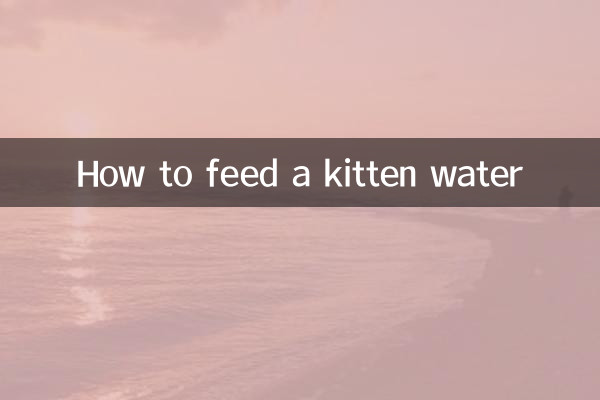How to Feed Kittens Water: Scientific Methods and Practical Tips
Cat owners know that water is an important part of a cat’s health. However, many novice cat owners may overlook the details of feeding their kittens water, leading to dehydration or other health problems. This article will combine the hot topics and hot content on the Internet in the past 10 days to introduce you in detail how to scientifically feed water to kittens.
1. Why is it important to feed kittens water?

Cats’ body water content is about 60%-70%, and water intake directly affects their kidney health, digestive function and overall vitality. Especially kittens, because of their fast metabolism, have a greater need for water. The following are health problems that may arise from a lack of water in cats:
| health problems | symptom |
|---|---|
| dehydration | Poor skin elasticity, sunken eyes, lethargy |
| urinary tract disease | Frequent urination, blood in urine, difficulty urinating |
| digestive problems | Constipation, loss of appetite |
2. How much water does a kitten need every day?
A cat's water needs are related to weight, diet and activity level. The following are reference data for kittens’ daily water requirements:
| Weight (kg) | Daily water requirement (ml) |
|---|---|
| 1 | 60-80 |
| 2 | 120-160 |
| 3 | 180-240 |
Note: If your cat mainly eats dry food, the water requirement will be higher; while wet food itself contains more water, the additional water intake can be appropriately reduced.
3. How to scientifically feed water to kittens?
1.Choose the right drinking water tool
Cats like clean, flowing water. Here are several common drinking tools and their pros and cons:
| Tool type | advantage | shortcoming |
|---|---|---|
| Ordinary water bowl | Low cost and easy to clean | Water gets dirty easily and cats have low interest |
| automatic water dispenser | Water flow attracts cats and filters water quality | Requires regular cleaning, higher price |
| Wide mouth shallow basin | Suitable for flat-faced cats | Water spills easily |
2.The placement of water is particular
Cats don’t like to drink water near food because they instinctively think the water source may be contaminated. suggestion:
3.Keep water fresh
Cats are very sensitive to the smell of water. It is recommended to:
4.Encourage kittens who don’t like to drink water
If your cat doesn't like drinking water, you can try the following methods:
| method | Specific operations |
|---|---|
| Wet food feeding | Choose canned foods with a water content of more than 70% |
| add flavor | Add a small amount of tuna juice or catnip to the water |
| ice cube game | Put ice cubes in the bowl to attract cats to play and drink water |
4. Answers to Frequently Asked Questions about Feeding Water
1.Q: Can kittens drink milk?
A: Most adult cats are lactose intolerant, which can cause diarrhea. It is recommended to choose specialized cat milk or goat milk.
2.Q: How to tell if a kitten is dehydrated?
A: Gently pull up the skin on the back of the neck. If it rebounds slowly (more than 2 seconds), it may be dehydrated and you need to seek medical attention in time.
3.Q: Is it normal for a kitten to suddenly drink a lot of water?
A: A sudden increase in water intake may be a sign of diabetes, kidney disease and other diseases. It is recommended to get checked as soon as possible.
5. Inventory of popular water feeding techniques across the Internet
According to the recent hot discussion on the Internet, the following are innovative water feeding methods shared by cat friends:
Conclusion
Scientific water feeding is an important part of ensuring the health of kittens. By choosing the right drinking tools, keeping the water fresh, and creating a good drinking environment, you can help your kitten develop good drinking habits. Remember, prevention is always better than cure. Regularly monitoring your cat’s water intake and urination can identify potential health problems early.

check the details

check the details